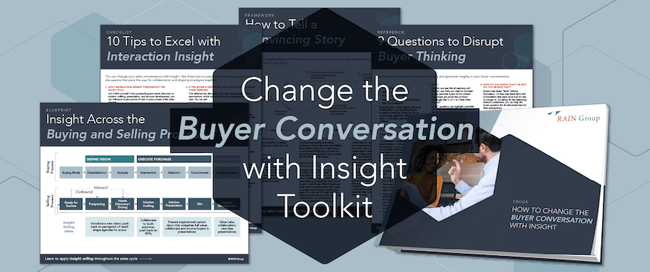Insight selling is an old concept that has recaptured the fancy of the sales world, and rightly so, because it’s about adding value. Specifically, it’s about the seller adding value over-and-above the product or service.
Too many folks, however, think insight selling is about educating buyers through presentations. They’re about half right, but without the other half, they’re missing out on the full impact of insight selling.
The missing link is asking questions. Or, as we call it, inquiry.
Insight selling in any form hinges on the concept of cognitive reframing. Cognitive reframing refers to creating alternative ways of viewing ideas, events, situations, possibilities for action, or anything.
Change a buyer’s perception of what’s true and what’s possible, and you can influence their agenda for action.
This is what insight selling is all about.
11 Questions to Bring Insight Selling Alive
1. Why?
"Why is that your strategy?" "Why do you say that?" "Why do A versus B?" By asking why, you are asking buyers to justify something. If they can do so convincingly, then bully for them! But oftentimes they can’t. Sometimes, when buyers respond to the “why” question, they give the insight to themselves. But even if they don’t, that’s an opportunity for you to help.
When you ask why questions, be careful not to put the buyer on the defensive. Deliver with a tone of inquiry and collaborative thinking, not of questioning their judgment. If you do the latter, you may find them hardening to defend a position. Keep the tone collaborative and you’ll find yourself thinking through things with them and often coming up with better solutions.
2. How?
How do you see this all panning out? How do you think you need to proceed so this becomes a part of the culture? How might you avoid the common challenges like X, or Y, or Z that commonly crop up?
How questions get people thinking about reality. Sometimes they have strong reasoning for why to do something, but they don’t have a strong plan for how to get things done. When you help them think about the how, it can help in many ways. You can help them avoid a problem. They might question the wisdom of doing something because they now see the true difficulties of implementation. They might—or you might—come up with a change to the plans that will make everything work better. In any case, how questions can be very powerful for generating insight.
3. What have you tried that hasn’t worked?
This question will help you understand their thinking and help you see the gaps between what they know won’t work and what you know will.
4. Have you considered A...B...C...etc.?
You may find out they did, but didn’t approach it right or didn’t know about a new advancement in the area. Maybe they didn’t know better options existed, so you can bring them to the table.
5. If I said I believe you might have under-invested to achieve this outcome in the past, what would you say?
When many buyers try to do something the first time, they look to cheaper options. Then those cheaper options fail.
This kind of question can push buyers out of their comfort zones. You challenge them, but not in a standoffish way. They might say, "Well, what should I have done?" Or, "The ROI wasn’t worth putting in more." Most answers give you opportunity to bring insight to the table.
6. What will the impact be if you did this?
Answers here can show:
- They see the impact and why it’s important (good!)
- Their perception of the impact grows as they think it out (great!)
- They see the impact as too small for action (you can show them it’s bigger!)
- They don’t know (you can help them figure it out!)
7. What will happen if you don’t act?
Asking this question gets buyers thinking of the negative consequences of inaction. They may work it out themselves ("We’ll bleed cash!" "Turnover will be unsustainably high!") and their perception changes. Perhaps they need your guidance to see the negative consequences of inaction. Either way...insight.
8. What’s possible?
What’s possible for results? What’s possible for action? What’s possible for solution choices? Like impact, whatever you find here gives you the chance to then alter their perception.
9. How do you know that?
Buyers often give "facts" without foundation. Or, they may give facts with foundation that once was true, but isn’t anymore. By asking for the reasoning behind a statement, you can help the buyer question the fundamental basis for their assumptions.
10. What do you think is missing?
This is the question that often gets a response of, "Good question!" Or, people get up on their soap boxes decrying what "should be" but isn’t. Openings for insight all around.
11. The follow-up question(s).
Ask a question and you may get a somewhat solid, somewhat thorough, and somewhat convincing answer. Keep pressing, though, and somewhat solid answers and arguments break down.
Even simply asking "why" a few more times can open the door for whole new paths of insight for the buyer. Like the example in this article, you can bring insight to the underlying cause of the problem and create a better and more durable solution.
For more questions like these, download our free guide, 50 Powerful Sales Questions.
These types of questions lead buyers to say (or, at least, think) things like, "Well, I wasn’t thinking of it like that." When they do, you’ve helped them achieve cognitive reframing: influencing the way they think and what they believe.
Influence buyers’ thinking with your thoughtful inquiry and you can then influence their agendas for action. The trend in selling has been to do this only through advocacy. Now you know how to do it with inquiry as well.







